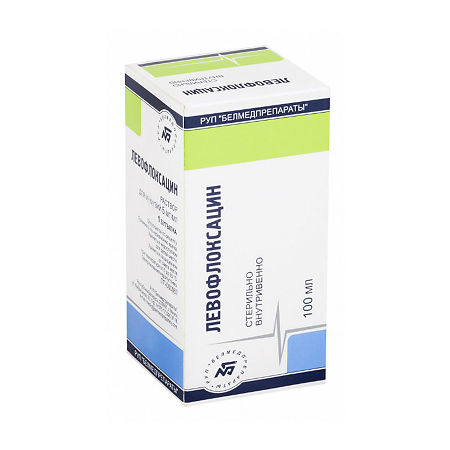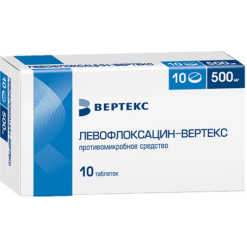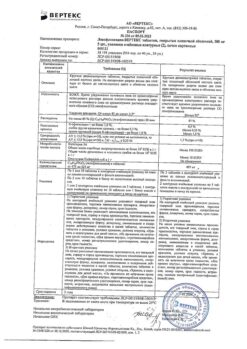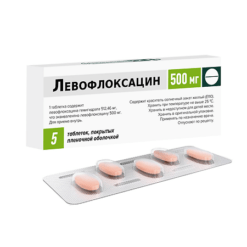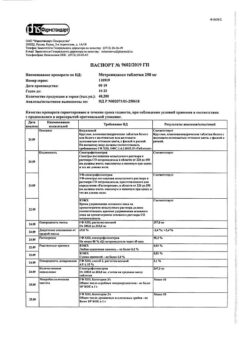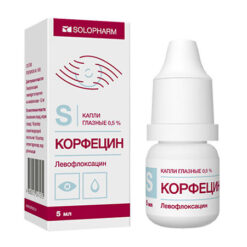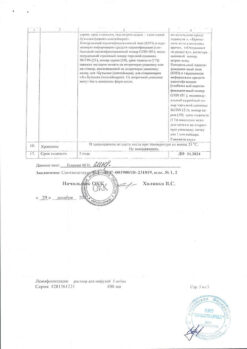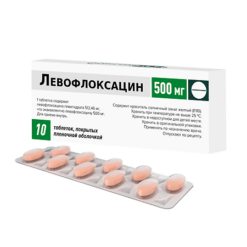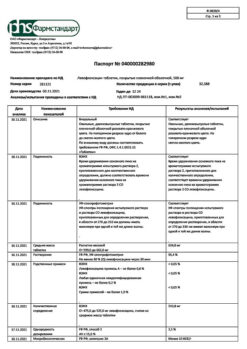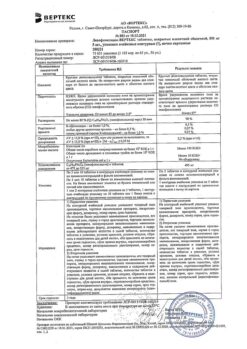No products in the cart.
Levofloxacin 5 mg/ml 100 ml
€1.00
Out of stock
(E-mail when Stock is available)
Description
A broad-spectrum antimicrobial agent, a fluoroquinolone. It acts bactericidally. It blocks DNA-enzyme (topoisomerase II) and topoisomerase IV, disrupts superspiralization and cross-linking of DNA breaks, inhibits DNA synthesis, causes deep morphological changes in cytoplasm, cell wall and membranes.
. Active against Enterococcus faecalis, Staphylococcus aureus, Staphylococcus epidermidis, Streptococcus pneumoniae, Streptococcus pyogenes and Streptococcus agalactiae, Viridans group streptococci, Enterobacter cloacae, Enterobacter aerogenes, Enterobacter agglomerans, Enterobacter sakazakii, Escherichia coli, Haemophilus influenzae, Haemophilus parainfluenzae, Klebsiella pneumoniae, Klebsiella oxytoca, Legionella pneumoniae, Moraxella catarrhalis, Proteus mirabilis, Pseudomonas aeruginosa, Pseudomonas fluorescens, Chlamydia pneumoniae, Mycoplasma pneumoniae, Acinetobacter anitratus, Acinetobacter baumannii, Acinetobacter calcoaceticus, Bordetella pertussis, Citrobacter diversus, Citrobacter freundii, Morganella morganii, Proteus vulgaris, Providencia rettgeri, Providcncia stuartii, Serratia marcescens, Clostridium perfringens.
Indications
Indications
For systemic use: lower respiratory tract infections (chronic bronchitis, pneumonia), ENT organs (sinusitis, otitis media), urinary and kidney tract infections (incl.urinary tract and kidneys (including acute pyelonephritis), genitals (including urogenital chlamydia), skin and soft tissues (suppurated atheromas, abscesses, furuncles).
For local use: treatment of anterior eye infections caused by microorganisms sensitive to levofloxacin.
Active ingredient
Active ingredient
How to take, the dosage
How to take, the dosage
It is used orally, intravenously, topically.
In sinusitis – orally, 500 mg once a day; in exacerbation of chronic bronchitis – 250-500 mg once a day. In pneumonia – orally, 250-500 mg 1-2 times a day (500-1000 mg/day); intravenously – 500 mg 1-2 times a day. In urinary tract infections – orally, 250 mg once daily or intravenously in the same dose. In cases of skin and soft tissue infections, 250-500 mg orally 1-2 times per day or intravenously, 500 mg 2 times per day. After intravenous injection, it is possible to switch to oral administration in the same dose after a few days.
In case of kidney diseases the dose is decreased according to the degree of function impairment: in IQ=20-50 ml/min – 125-250 mg 1-2 times/day, in IQ=10-19 ml/min – 125 mg 1 time 12-48 h, in IQ<10 ml/min – 125 mg every 24 or 48 h. The duration of treatment is 7-10 (up to 14) days.
It is used topically in the form of eye drops. Adults and children over 1 year old are put in 1-2 drops in the affected eye(s) every 2 hours up to 8 times/day while awake for the first 2 days, then 4 times/day from day 3 to day 7. The duration of application is 5-7 days.
Interaction
Interaction
Levofloxacin increases T1/2 cyclosporine.
The effect of levofloxacin is reduced by drugs that inhibit intestinal motility, sucralfate, magnesium- and aluminum-containing antacids and iron salts (a break of at least 2 hours between doses is necessary).
Concomitant use of NSAIDs, theophylline increases seizure activity, and GCS increases the risk of tendon rupture.
Cimetidine and drugs that block tubular secretion slow the excretion of levofloxacin.
The levofloxacin solution for intravenous administration is compatible with 0.9% sodium chloride solution, 5% dextrose solution, 2.5% Ringer’s solution with dextrose, combined solutions for parenteral nutrition (amino acids, carbohydrates, electrolytes).
Levofloxacin solution for intravenous administration should not be mixed with heparin and solutions that have an alkaline reaction.
Special Instructions
Special Instructions
Cautious use of levofloxacin in elderly patients (high probability of concomitant reduction of renal function).
After normalization of temperature it is recommended to continue treatment for at least 48-78 hours.
At the time of treatment, sunlight and artificial UV exposure should be avoided to avoid damage to the skin (photosensitization).
In case of signs of tendinitis, levofloxacin should be stopped immediately. It should be noted that in patients with brain damage in anamnesis (stroke, severe trauma) seizures may develop, in case of glucose-6-phosphate dehydrogenase deficiency there may be a risk of hemolysis.
Impact on the ability to drive vehicles and mechanisms
At the time of treatment it is necessary to refrain from potentially dangerous activities requiring increased concentration and rapid psychomotor reactions.
Features
Features
When taken orally it is absorbed from the gastrointestinal tract quickly and almost completely. Food intake has little effect on the speed and completeness of absorption. Bioavailability is 99%. Cmax is reached after 1-2 hours and is 2.8 and 5.2 mcg/ml when taken in 250 mg and 500 mg, respectively. Binding to plasma proteins is 30-40%.
It penetrates well into organs and tissues: lungs, bronchial mucosa, sputum, urogenital organs, polymorphonuclear leukocytes, alveolar macrophages. A small portion is oxidized and/or deacetylated in the liver. Renal clearance is 70% of total clearance.
T1/2 is 6-8 h. It is excreted mainly by the kidneys through glomerular filtration and tubular secretion. Less than 5% of levofloxacin is excreted as metabolites. During 24 hours 70% is excreted unchanged in the urine and 87% during 48 hours; during 72 hours 4% of the dose taken orally is excreted in the feces.
After an IV infusion at a dose of 500 mg for 60 min, Cmax is 6.2 µg/ml. For single and multiple infusions, the apparent Vd after the same dose is 89-112 L, Cmax is 6.2 µg/mL, and T1/2 is 6.4 h.
After instillation into the eye, levofloxacin is well preserved in the tear film. In healthy volunteers, the mean concentrations of levofloxacin in the tear film measured 4 and 6 h after topical administration were 17 µg/mL and 6.6 µg/mL, respectively. Five of 6 volunteers had levofloxacin concentrations of 2 µg/mL or higher 4 h after instillation. In 4 of 6 volunteers this concentration was maintained 6 h after instillation. Mean plasma concentrations of levofloxacin 1 h after administration ranged from 0.86 ng/mL at 1 day to 2.05 ng/mL. Cmax of levofloxacin in plasma, equal to 2.25 ng/ml, was detected at 4 days after two days of using the drug every 2 h up to 8 times/day. Cmaxlevofloxacin reached on day 15 was more than 1,000 times lower than concentrations seen after oral administration of standard doses of levofloxacin.
Contraindications
Contraindications
Side effects
Side effects
Digestive system disorders: nausea, vomiting, diarrhea, anorexia, abdominal pain, pseudomembranous enterocolitis, increased liver transaminases activity, hyperbilirubinemia, hepatitis, dysbacteriosis.
Cardiovascular system disorders: decreased BP, vascular collapse, tachycardia.
Metabolic disorders: hypoglycemia (increased appetite, sweating, shivering).
CNS and peripheral nervous system disorders: headache, dizziness, weakness, drowsiness, insomnia, paresthesias, anxiety, fear, hallucinations, confusion, depression, motor disorders, seizures.
Sensory organs: disorders of vision, hearing, smell, taste and tactile sensitivity. Local administration – transient burning of the eyes, red eyes, decreased visual acuity, appearance of mucus in the form of tear film, blepharitis, chemosis, papillary overgrowths and appearance of follicles on the conjunctiva, dry eye syndrome, erythema of the eyelids, itching and pain in the eyes, photophobia.
Muscular system disorders: arthralgia, myalgia, tendon rupture, muscle weakness, tendinitis.
Urinary system disorders: hypercreatininemia, interstitial nephritis.
Hematopoietic system disorders: eosinophilia, hemolytic anemia, leukopenia, neutropenia, agranulocytosis, thrombocytopenia, pancytopenia, hemorrhages.
Dermatological reactions: photosensitization, itching, swelling of the skin and mucous membranes, erythema malignant exudative (Stevens-Johnson syndrome), toxic epidermal necrolysis (Lyell’s syndrome).
Allergic reactions: urticaria, bronchospasm, choking, anaphylactic shock, allergic pneumonitis, vasculitis.
Others: exacerbation of porphyria, rhabdomyolysis, persistent fever, development of superinfection.
Similarities
Similarities
Additional information
| Manufacturer | Belmedpreparaty, Belarus |
|---|---|
| Medication form | solution for infusion |
| Brand | Belmedpreparaty |
Other forms…
Related products
Buy Levofloxacin 5 mg/ml 100 ml with delivery to USA, UK, Europe and over 120 other countries.

